Although Yves Saint Laurent is (rightly) credited with popularizing the tuxedo for women, called “Le Smoking” (click here for his 1966 version,) it was an idea that had been explored before, in other decades when women began to assume traditionally masculine roles.
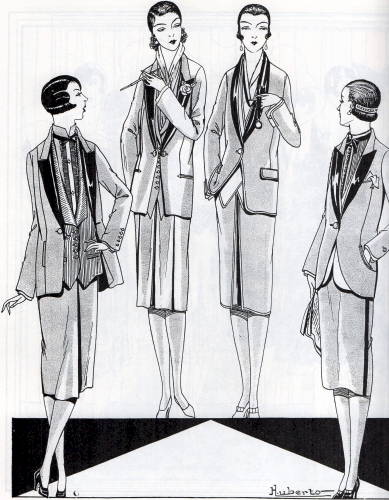
“Le Smoking” for women, illustrated by Humberto in 1926. From Authentic French Fashions of the Twenties, ed. JoAnne Olian.
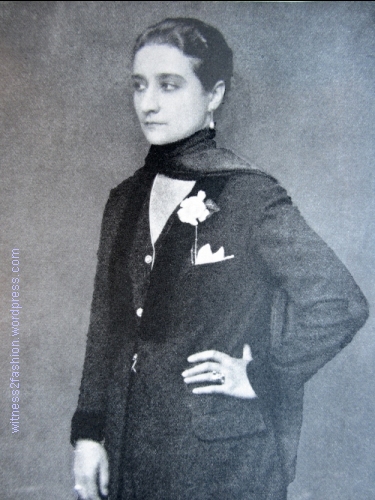
The singer Dora Stoeva, Delineator magazine, March 1924. Her jacket seems to have a black velvet lapel and cuffs, worn over a vest with white piping, but no shirt.
The boutonniere and pocket hanky were usual in male evening dress. The first versions of le smoking may have appeared before the nineteen twenties. In fact, this Punch cartoon reprinted in The Way to Wear-em, by Christina Walkley, deserves more research:
The caption purports to be a quotation from Journal des Modes, 1st April, and says:
” ‘Man or Woman?” — A toss up. ‘Dresses are still universally cut en coeur. A very dressy toilette, and one, much worn now, for the Evening, is of black Broche or cloth material cut en Habit d’Homme, with plain or kilted skirt, very tight; for fair ladies it is very becoming to omit a tucker, and have the black and white with no softening.”
Anyone with access to Journal des Modes, from about 1879 to 1880, might have fun looking for the page that inspired the cartoonist — and the original illustration, if any.
Meanwhile, here’s a closer look at those “smokings” for women from 1926:
From the left:
She is also wearing a Victorian-looking ruffled tuxedo shirt with a simply tied black ribbon in place of a bow tie. The skirt appears to have a center front pleat.
Don’t be misled by the black and white illustrations; this “smoking” is not black, but ivory white.
It also is worn with a pleated skirt. The “smoking” below is not black, either:
Under it, there’s a woman’s V-neck shawl collared blouse with French cuffs. She wears a monocle on a ribbon, rather than a necklace.
A man’s tuxedo shirt would not have as many buttons as this pleated shirt has; it has a slight standing collar instead of a wing collar, and has a silk ribbon tied once, rather than a bow tie. I especially like the strip of braid at the side of the skirt; men’s tuxedo trousers always had such braid at the side seams.
In the nineteen twenties and thirties, men’s formal evening dress and tuxedos were sometimes navy blue, instead of black. It was thought that navy looked better under the lighting at dances and dinner parties. [This is a problem for theatrical costumers drawing from real period stock; navy blue wool can turn surprising colors under stage lights, including brown, maroon, or cranberry red.]
The illustration by Humberto is taken from JoAnne Olian’s Authentic French Fashions of the Twenties, page 108, dated February 27, 1926. It’s available in paperback or as a Nook Book.
The woman’s tuxedo suit has longevity. This one, by Yves Saint Laurent, in the collection of the Metropolitan museum, dates to 1973-77.
This one, from Donna Karan, appeared in 1998:
And these celebrities all wore tuxedo suits to the same event in 2011. (Click here.) Described at popsugar.
Marie Claire showed this (undated) version even more recently. Click Here.
Viva le smoking!

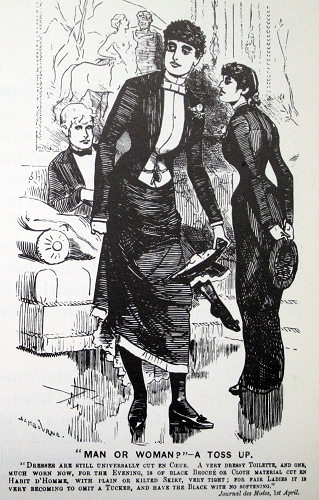

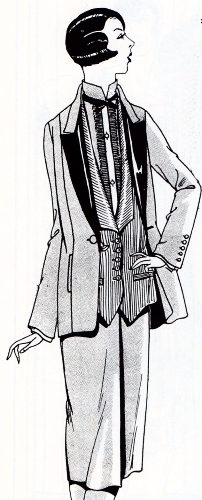
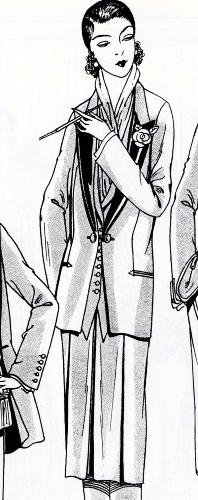


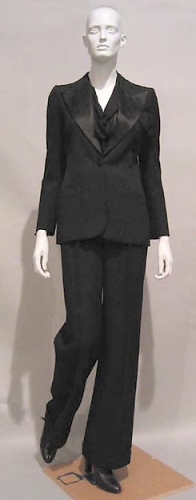
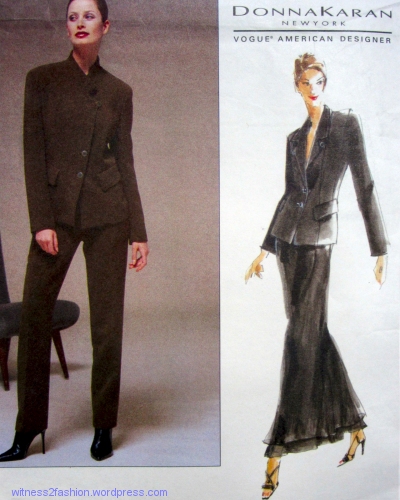
Wonderful! Those beautiful tuxedo jackets are a sewing holy grail for me–one day when I have more confidence I would like to make one. And this shows that I doesn’t have to be black! Some years ago I saw an Yves St. Laurent show in Denver (different than the one in San Francisco.) My favorite room was one that had many, many variations on Le Smoking.
I found your blog recently and I LOVE IT! I study and make historical clothing for myself. I discovered you while searching for detailed information on women’s undergarments in the 1920s. I read all your posts on that topic and many more! Thank you for the excellent historical information you research and share. I especially appreciate your common sense as you peer into the past and the love of fashion you bring to your blog. Love it!
Golly, thank you! The list of useful sites at the right has some amazing resources for research which weren’t around just a couple of years ago. The digital library at UCLA links to thousands of images and to 18th & 19th c. magazines, and the Commercial Pattern Archive has over 45,000 pattern envelope images. It’s amazing what we can find today.
Loved this. I wonder if Saint Laurent was aware of the 1920s tuxedo-inspired suits? I’m betting he did.
Great post! When I was doing research for my 1920’s women’s coats and jackets post, it was really hard to find any specific information about women’s suit jackets, etc. It’s really interesting and even though I didn’t know women also worn the tuxedo during this decade, it doesn’t surprise me. Amazing! Always learning, thank you! 🙂
I suspect that relatively few women wore these tuxedo suits in the 1920s — but those who did, were noticed. Women did begin appropriating men’s styles in order to lead a more active life in the 19th c., and even wearing an overcoat (“ulster”) instead of a shawl was satirized by cartoonists in the late 1800’s.
Exactly! Maybe those were the same few women who also dare to wear trousers outside home during the 1920s!